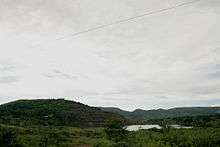Serra Pelada
Serra Pelada (English: "Naked Mountain") is a Brazilian village, district of the municipality of Curionópolis, in the southeast of Pará.
 The former pit of Serra Pelada now forms a lake | |
| Location | |
|---|---|
 Serra Pelada Mine Location in Brazil | |
| State | Pará |
| Country | Brazil |
| Coordinates | 5°56′39″S 49°39′53″W |
| Production | |
| Products | Gold |
| Production | Official records: 44.5 tons Black market estimate: 360 tons[1] |
| History | |
| Opened | 1980 |
| Closed | 1986 |
Serra Pelada was a large gold mine in Brazil 430 kilometres (270 mi) south of the mouth of the Amazon River. The mine was made infamous by the still images taken by Alfredo Jaar and later by Sebastião Salgado and the first section of Godfrey Reggio's 1988 documentary Powaqqatsi, showing an anthill of workers moving vast amounts of ore by hand. Because of the chaotic nature of the operation estimating the number of miners was difficult, but at least 100,000 people were thought to be present, making it one of the largest mines in the world.[2] Today the Serra Pelada mine is abandoned and the giant open pit that was created by hand has filled with water, creating a small polluted lake.[3]
Discovery
In January 1979, farmer Genésio Ferreira da Silva hired a geologist to investigate whether gold he found on his property was part of a larger deposit. A local child swimming on the banks of a local river found a 6-gram (0.21 oz) nugget of gold.[4] Soon word leaked out that da Silva was indeed sitting upon one of the largest deposits in the world. By the end of the week a gold rush had started with thousands of people descending upon the farm to mine.[5] Five weeks later, there were 10,000 on Ferreira's property and another 12,000 nearby. Huge nuggets were quickly discovered, the biggest weighing nearly 6.8 kilograms (15 lb), $108,000 at the 1980 market price[5] (now $335,123 in 2020).
At first the only way to get to the remote site was by plane or foot. Miners would often pay exorbitant prices to have taxis drive them from the nearest town to the end of a dirt track; from there, they would walk the remaining distance—some 15 kilometres (9 mi)—to the site. The growing town, since it could only be made of material that was carried in by hand, was a collection of haphazard shacks and tents.[2] Each miner had a 2 metres (6 ft 7 in) by 3 metres (9.8 ft) claim. By May 1980 there were 4,000 such claims.[6]
Military conflict
Early in the history of the mine, the Brazilian military took over operations to prevent exploitation of the workers and conflict between miners and owners. Before the military takeover basic goods were sold for hugely inflated prices by the mine owners; water cost $3 a litre ($9.31 in 2020).[5] The infamous Sebastião Rodrigues de Moura (known more by his nickname Coronel Curió) managed the mine for a brief period.[7]
While the military government banned the presence of women and alcohol at the actual mine, the nearby town provided space for women and banned objects. Thousands of women and underage girls engaged in sex work in exchange for gold. Around 60–80 unsolved murders occurred in the town every month.[4]
Environmental damage
Because of the use of mercury in the gold extraction process large areas around the mine are considered dangerously contaminated.[8] People eating fish downstream from the mine have elevated mercury levels.[8]
In popular media
- Brazilian comedy group Os Trapalhões made in 1982 Os Trapalhões na Serra Pelada,[9] where four friends try to strike it rich at the Serra Pelada mine.
- A documentary video "Gold Lust" created by Neil Hollander in 1984, aired by WNET and narrated by Orson Welles.[10]
- Powaqqatsi, a 1988 documentary film, opens with footage of Serra Pelada
- The Rundown. a 2003 American comedy film, occurs at a fictional mine with many elements based on the Serra Pelada.
- Serra Pelada, 2013 Brazilian action film
- The Salt of the Earth, a 2014 documentary film about Brazilian photographer Sebastião Salgado, whose most iconic works featured the miners of Serra Pelada
Bibliography
Notes
- Watras & Huckabee 1994, p. 23.
- Waszkis 1993, p. 193.
- Eakin 1998, p. 248.
- Negus 2007.
- Time 1980, p. 2.
- Waszkis 1993, p. 194.
- Wright & Wolford 2003, p. 38.
- Watras & Huckabee 1994, p. 33.
- Os Trapalhões na Serra Pelada on IMDb.
- "Gold Lust (1984) - Movie | Moviefone". AOL Moviefone. Retrieved 14 June 2016.
References
- Eakin, Marshall C. (1998). Brazil: The Once and Future Country. Palgrave Macmillan. ISBN 0-312-21445-6.CS1 maint: ref=harv (link) 320 pp.
- Negus, George (September 26, 2007). "Treasure of Serra Pelada". 60 Minutes. AU: Nine MSN. Retrieved February 16, 2010.CS1 maint: ref=harv (link)
- "Brazil: The Treasure of Serra Pelada". Time. Sep 8, 1980. Retrieved February 15, 2010.
- Waszkis, Helmut (1993). Mining in the Americas: stories and history. Woodhead Publishing. ISBN 1-85573-131-2.CS1 maint: ref=harv (link) 280 pp.
- Watras, Carl J.; Huckabee, John W. (1994). Mercury pollution: integration and synthesis. CRC Press. ISBN 1-56670-066-3.CS1 maint: ref=harv (link) 727 pp.
- Wright, Angus Lindsay; Wolford, Wendy (2003). To inherit the earth: the landless movement and the struggle for a new Brazil. Food First Books. ISBN 0-935028-90-0.CS1 maint: ref=harv (link) 368 pp.